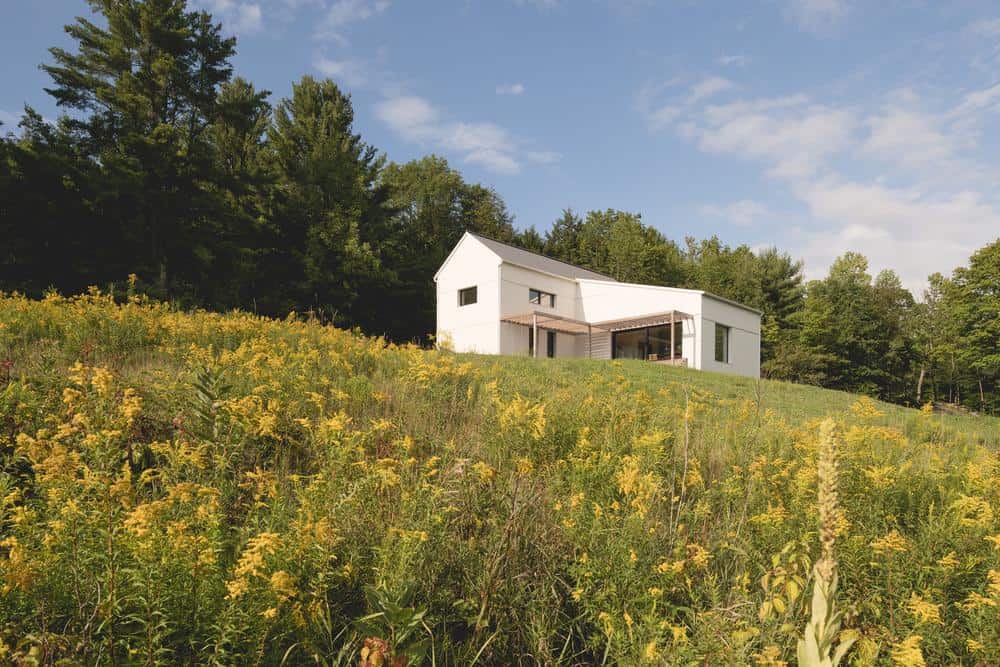The Saltbox Passive House is a primary residence designed for a family of four and built on the southern flank of Mont Gale in Bromont, in the Eastern Townships in Quebec.

The 3,100-sq.-ft. single-family home, built on three levels, sits in a meadow at the edge of a wooded, protected area on a 2.5-acre lot. The house, whose design is inspired by the region’s architectural heritage, achieved LEED Platinum and Passive House Institute U.S. 2018+ certifications, making it the third house to obtain passive house certification in Quebec.
L’Abri, an architecture and construction firm based in Montreal, worked with consultants, the builder and a Passive House Institute U.S. (PHIUS) consultant.

“The nature of the site and the local vernacular architecture prompted us to turn to a historical form,” say the architects. “With its ‘L’ layout and the combination of two types of roof slopes, the house borrows its silhouette from the vocabulary of rural Saltbox-type buildings, which sprang up in 17th-century New England and which still pepper the countryside of the Eastern Townships.
“With a gable roof on the main section and single pitch roof on the lower section, this colonial style takes its name from the lidded containers where salt was once kept above the hearth to keep it dry.”
The house faces south to favour passive solar heating and panoramic views over the valley. The construction on three levels is nestled into the mountain to minimize the visibility of the retaining walls, say the architects. By building the rear part of the ground floor at garden level, and by opting for a roof slope that mirrors the land, the house echoes the topography of the location while remaining discreet from the street, revealing itself only once visitors are on the driveway. The third and lowest level houses a garage, which also serves as a workshop and remains hidden until the final approach.
“Inside, the living spaces are generous and bright. Illuminated by three large openings which contribute to the passive heating of the building, the central double-height room is the real heart of the house,” say the architects. “Its functions are organized around a central block, which comprises the mudroom, the kitchen, the pantry and a powder room. This white volume abuts the second floor corridor, which serves as a passageway to the bedrooms and a small mezzanine home office.
“To the north, the children’s bedrooms are lit by narrow horizontal bands that frame the forest that borders the house, all while limiting heat loss. In the crook of the L sits a terrace partially protected by pergolas, which serve as sunscreens and passively regulate the interior temperature of the house.”

The retaining walls are constructed of excavated stone. The main cladding is wood and the entrance section is burnt cedar. The home has a grey steel roof.
The term Passive House refers to a high-performance building standard that promotes energy efficiency, comfort and the sustainability of buildings. Developed 30 years ago in Germany by the Passivhaus Institut, the standard means, among other things, heating and cooling energy savings of around 80 per cent, say the architects.
The basic principles of the standard are a highly insulated and very airtight envelope, superior heat recovery of the mechanical ventilation system and a design that optimizes the orientation and sizing of openings to promote passive heating of the building.
“Contrary to popular belief, these buildings are not off the grid but their energy consumption and their dependence on utilities are drastically reduced,” say the architects. “Achieving the performance criteria of a passive house is only possible with the close collaboration of the architect, the consultants and the builder, which is why we favoured an integrated design approach from the very start. This experience confirmed to us that a building can be both esthetic, in harmony with its environment and extremely efficient.”
The L’Abri architecture team includes Francis M. Labrecque, Jérôme Codère, Vincent Pasquier and Antoine Mathys. The contractor was Construction Rocket and the PHIUS consultant was Sarah Cobb.

















